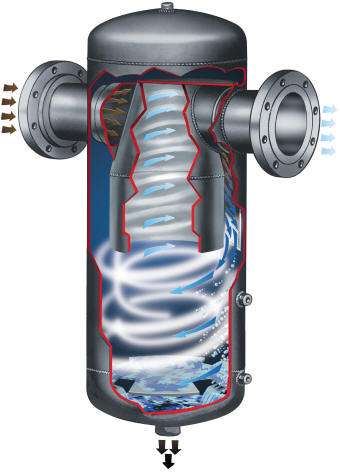Cyclone Steam Separators
Steam separator design
Call us at 908.362.9981 to speak with a sales engineer
| Slug of condensate being swept downstream |
Why Remove Entrained Condensate?
Dry steam is preferred for direct contact applications involving steam powered equipment, cooking and atomization of other liquids because the liquid itself is damaging to the equipment (corrosion) or process (contamination). High velocity impact of entrained water droplets contribute to erosive damage of critical pipeline components such as pressure reducing valves. Reclamation of treated boiler water reduces the consumption of boiler treatment chemicals, a significant cost savings.
Steam Applications Protected By Separators include:
-
Steam turbine power generation
-
Jacketed vessels, cooking surfaces, application directly onto food
-
Autoclaves
-
Coils for space and liquid heating
-
Vulcanization of rubber
-
Corrugation of cardboard

Cyclone steam separators employ centrifugal
force, change in direction and reduction in velocity to ensure 99% of
droplets greater than 10 microns do not pass though the separator.
Our cyclone steam separators have no internal moving parts or
serviceable components, it is simply a fully welded pressure vessel.
The cyclonic action with droplets and pipe scale continuously scour the
inside of the separator keeping it clean and thus there is no maintenance required.
The only cost is the initial procurement and installation of the
separator, thereafter they will function reliably and reduce operating
costs for decades.
Re-entrainment of separated condensate is
prevented by a containment plate which prevents agitation of the pooled
condensate by the vortex. Although this is not "universal" to
centrifugal separator designs, the models we offer all have this
critical feature.
Whereas impingement plate style separators have
a turndown limit, our centrifugal steam separators have an infinite turn
down ratio. This aspect is critical during start-up and shut down
phases of a steam system.
Cyclonic
steam separators are designed to handle horizontal and vertical flow paths
as well as combinations thereof and our standard materials include cast iron,
carbon steel and stainless steel. We offer other alloys of
construction which are commonplace at chemical plants and refineries.
Exhaust heads are a special type of cyclone separator installed at
the end of a vent pipe to reduce the opacity and carry-out of vapor
contaminated with boiler treatment chemicals. This treated boiler
water can be reclaimed and
reused, reducing chemical consumption. Unlike separators, exhaust heads
are not pressure vessels because the outlet is always open to
atmospheric pressure.
Use our
steam separator sizing tool to determine the appropriate separator
size for your application. Remember that











